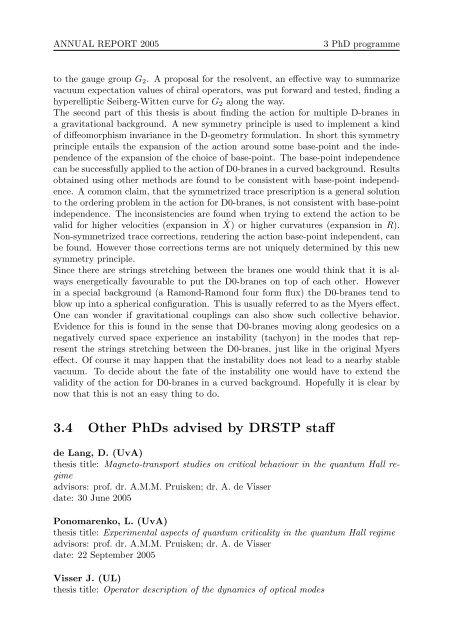ANNUAL REPORT 2005 - Universiteit Utrecht
ANNUAL REPORT 2005 - Universiteit Utrecht
ANNUAL REPORT 2005 - Universiteit Utrecht
Create successful ePaper yourself
Turn your PDF publications into a flip-book with our unique Google optimized e-Paper software.
<strong>ANNUAL</strong> <strong>REPORT</strong> <strong>2005</strong>3 PhD programmeto the gauge group G 2 . A proposal for the resolvent, an effective way to summarizevacuum expectation values of chiral operators, was put forward and tested, finding ahyperelliptic Seiberg-Witten curve for G 2 along the way.The second part of this thesis is about finding the action for multiple D-branes ina gravitational background. A new symmetry principle is used to implement a kindof diffeomorphism invariance in the D-geometry formulation. In short this symmetryprinciple entails the expansion of the action around some base-point and the independenceof the expansion of the choice of base-point. The base-point independencecan be successfully applied to the action of D0-branes in a curved background. Resultsobtained using other methods are found to be consistent with base-point independence.A common claim, that the symmetrized trace prescription is a general solutionto the ordering problem in the action for D0-branes, is not consistent with base-pointindependence. The inconsistencies are found when trying to extend the action to bevalid for higher velocities (expansion in Ẋ) or higher curvatures (expansion in R).Non-symmetrized trace corrections, rendering the action base-point independent, canbe found. However those corrections terms are not uniquely determined by this newsymmetry principle.Since there are strings stretching between the branes one would think that it is alwaysenergetically favourable to put the D0-branes on top of each other. Howeverin a special background (a Ramond-Ramond four form flux) the D0-branes tend toblow up into a spherical configuration. This is usually referred to as the Myers effect.One can wonder if gravitational couplings can also show such collective behavior.Evidence for this is found in the sense that D0-branes moving along geodesics on anegatively curved space experience an instability (tachyon) in the modes that representthe strings stretching between the D0-branes, just like in the original Myerseffect. Of course it may happen that the instability does not lead to a nearby stablevacuum. To decide about the fate of the instability one would have to extend thevalidity of the action for D0-branes in a curved background. Hopefully it is clear bynow that this is not an easy thing to do.3.4 Other PhDs advised by DRSTP staffde Lang, D. (UvA)thesis title: Magneto-transport studies on critical behaviour in the quantum Hall regimeadvisors: prof. dr. A.M.M. Pruisken; dr. A. de Visserdate: 30 June <strong>2005</strong>Ponomarenko, L. (UvA)thesis title: Experimental aspects of quantum criticality in the quantum Hall regimeadvisors: prof. dr. A.M.M. Pruisken; dr. A. de Visserdate: 22 September <strong>2005</strong>Visser J. (UL)thesis title: Operator description of the dynamics of optical modes
















